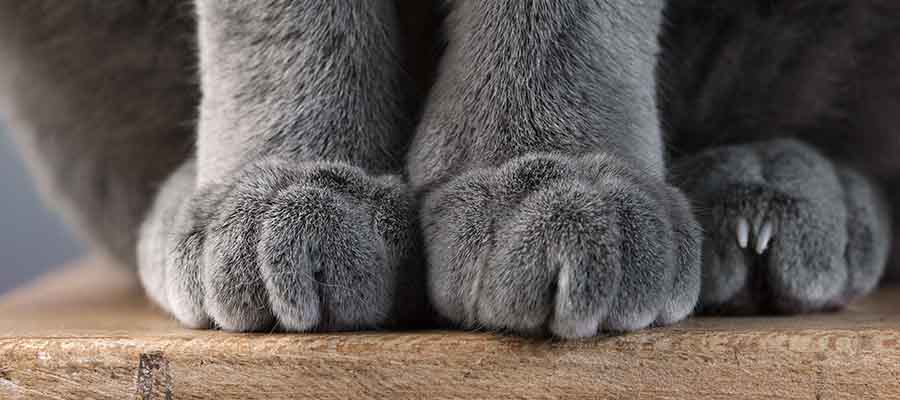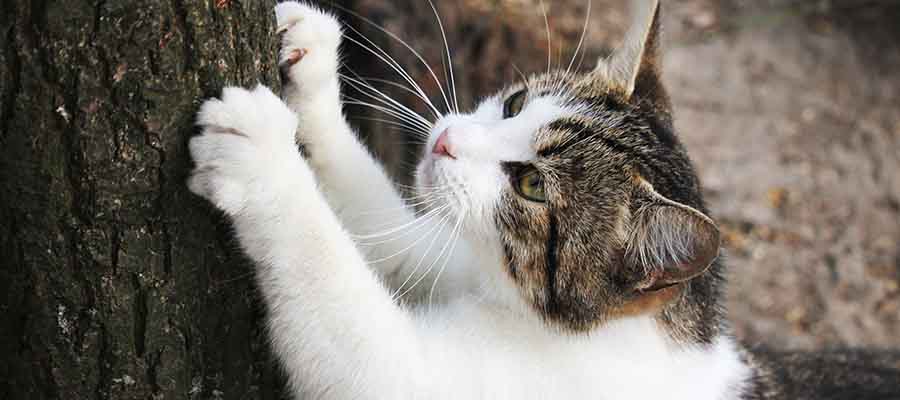Cats having claws is perfectly natural - in fact they're so important to cats that 'de-clawing' is illegal in the UK. But sometimes, they can get a little too long if your cat isn’t able to wear them down properly.
It's always best to give your cat ways to wear their claws down naturally rather than clipping them. If they're given lots of opportunity to scratch and condition their claws, they're more likely to stay a good length so you won't need to trim them. You can read our top tips to help keep your cat's claws in good condition below.
How do I know if my cat’s claws are too long?

If you’ve ever been playing with your cat and gotten a little too close, you might have felt just how sharp their claws are! While playing, it’s natural to be able to see your cat’s claws. Cats’ front claws are retractable, meaning that when they’re resting you’re unlikely to be able to see them at all. This also means that when they walk, they can do so quietly and without getting stuck on anything.
If your cat’s claws are too long, you might notice they’re starting to catch on the carpet or tap against hard floors. You may be able to clearly see their claws, even when they’re resting. As our cats get older it’s definitely worth keeping an eye on their claws. If they develop arthritis, can’t retract their claws, or find it painful to claw things to keep their claws sharp and short they may need a bit of extra help. Long-haired cats in particular need regular checking as it can be hard to see if their claws are too long because of all the excess fur!
If your cat’s claws get too long, they can start to curve and grow into their paw pads causing a lot of pain and problems for your kitty. It’s best to keep an eye on your cat’s claws so you know if they’re starting to get too long and if you suspect they’ve grown into the pad, it’s best to call your vet for their help.
We’d always recommend a chat with your vet team first if you think there is something wrong with your cat’s claws (for example, if they have grown into the pad or you can see blood or swelling in their toes). A visit might not be so easy given the current situation, so give them a call to discuss what could be wrong over the phone first.
My cat’s claws are too long – how can I cut them?
You should only trim your cat’s nails if they are too long, not because they are sharp. It’s best to speak to your vet if you’re unsure. If your vet has advised you to cut your cat’s claws, you need to do so slowly and carefully. You’ll need some cat nail clippers or cat nail scissors, and your cat’s favourite treats. We wouldn’t recommend using human nail clippers, as these can cause your cat’s claws to split. You can buy cat nail clippers from the PDSA Pet Store online.
It’s also important to remember that once you’ve trimmed your cats nails they will want to sharpen them again so be prepared for them to scratch more (and sometimes in new places!) to get their nails back to their normal pointed shape.
For a good few days before, you’ll want to get your cat used to having their paws touched. Start to build them up by gently touching their paws and giving them a treat if they stay calm, but stop if they start to look uncomfortable or stressed.
When they’re happy to have their paws touched, you can start clipping:
- Settle your cat in a quiet room, ideally somewhere you can easily get to their paws (so try to avoid getting them settled on top of a wardrobe). On your lap is ideal. You want them to be nice and relaxed before starting. Make sure you have a soft surface for them to land on if they decide to jump down for example putting down some cushions next to the chair.
- Make sure your cat is happy with the clippers. Let them sniff them and investigate if they’re interested and give them a tasty reward.
- Apply gentle pressure to the top and bottom of your cat’s paw to extend their claws. You may have to push a little but this should only be very gentle.
- Avoid the quick at the base of the claw nearest the toe – this is the pink bit of your cat’s claw and contains a small blood vessel. You should never cut this bit as it will bleed and be painful to your kitty. Just stick to the white safe area at the tip and if you can see the quick it’s best to clip about 3-4mm below this.
- It’s very rare to make a claw bleed as the quick is usually obvious but if you do notice any blood, stop and call your vet for advice.
- Take your time and don’t try to cut all your cat’s claws in one sitting. Try trimming one first, then reward your cat. If that didn’t send them running, trim another then reward them again. Stop straight away if your cat is unhappy or trying to run away.
- Never shout at your cat or hold them too tightly. You want claw clipping to be a good experience for them so they won’t mind it so much in future. Shouting or holding them tightly will only make them hate it even more and send them packing as soon as they see you with the clippers!
How can I help my cat to keep their claws in good condition?

Outdoor, active cats shouldn’t need their claws clipping. In the wild, your cat would wear them down running, hunting, climbing, playing and scratching. Your pet should be no different! But indoor or older cats can be more at risk of getting longer claws.
Here are our top tips for keeping your kitty’s claws in shape:
- Keep them active. The more your cat runs, plays and climbs inside and out, the more likely they are to naturally wear away the tips of their claws.
- Provide a scratching post or three! Cats love to scratch and it’s a natural part of their behaviour. Having a few scratching posts around the house can be a great way to encourage them to wear those claws down (and save your carpets and furniture!). Some cats like vertical scratching posts and others prefer horizontal, like a scratching box. Find out where your cat is scratching around the house and try to mimic it with things you would prefer your cat to be scratching! Using pheromone sprays can encourage your cat to use the scratching post rather than your carpets and furniture.
- Keep them slim. A podgy cat is going to be reluctant to exercise and won’t want to spend much time on their feet. Keeping your cat in shape will help them to stay active and wearing those claws down. Read our advice on obesity in cats.
- Speak with your vet. As cats get older, normal clawing behaviours can be more difficult for some cats, especially if they are suffering with arthritis or sore joints. If you noticed your cat’s claws are getting too long and you’ve already tried the above tips, speak to your vet – they may be able to supply medication to help your cat feel more comfortable and able to perform these normal behaviours.

